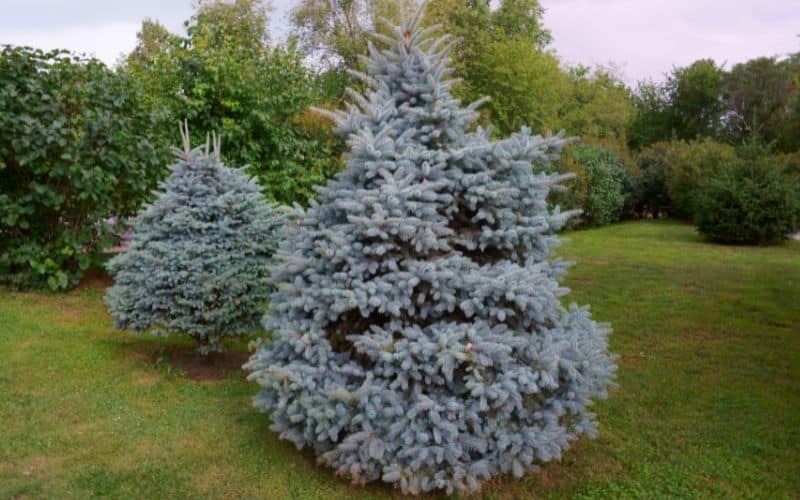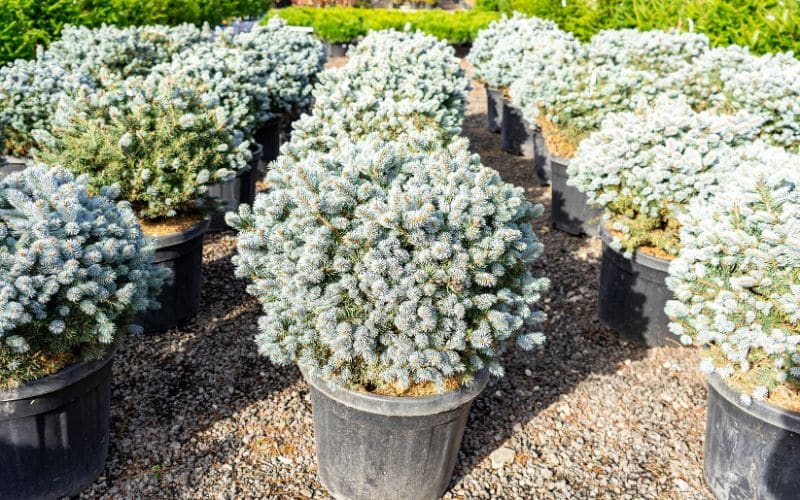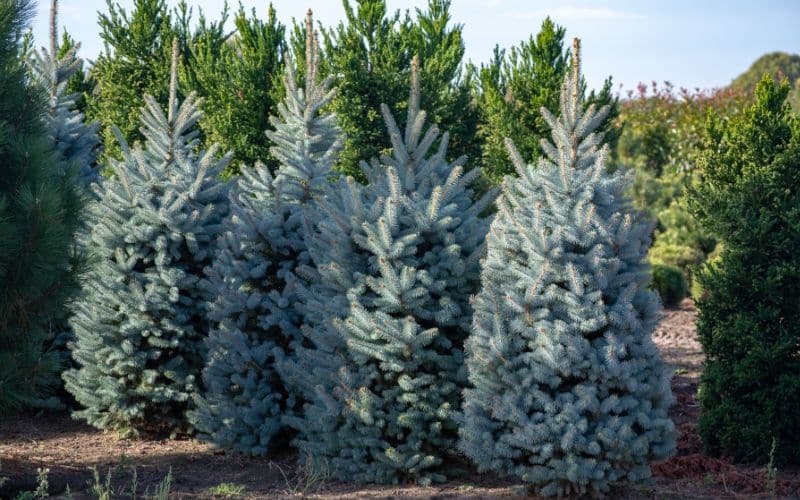
Standing tall and majestic, the Blue Spruce trees are a sight to behold in Ontario. Known for their stunning silvery-blue needles and pyramid-like shape, they’ve become a staple in many Canadian landscapes. These hardy conifers have the ability to thrive in Ontario’s harsh climate conditions making them not only aesthetically pleasing but also resilient.
When you’re strolling through an Ontarian park or simply driving down residential streets, it’s easy to spot these iconic trees that add charm to any landscape. They offer more than just visual appeal; Blue Spruces provide shelter for wildlife and help reduce carbon dioxide levels – truly playing their part in maintaining our ecosystem.
Understanding how best to care for your Blue Spruce can ensure its health and longevity. It’s important you’re familiar with its water requirements, optimal soil conditions, potential diseases it might face – all of which we’ll delve into throughout this article.
Understanding the Blue Spruce
Dive into the world of Ontario’s nature, and you’ll quickly discover the magnificent Blue Spruce. Native to North America, this coniferous tree is a favourite among homeowners for its distinctive bluish-green needles and robust structure.
Standing tall with heights reaching up to 25 metres, they’re an impressive sight in any garden or landscape. Here’s what makes them unique:
- Distinctive colour: The ‘blue’ in Blue Spruce comes from their stunning bluish-grey needles. It’s not just aesthetics though – this coating also helps protect them from drying winds and freezing temperatures.
- Resilience: These trees are hardy! They can withstand harsh weather conditions, including frosty winters that are common in Ontario.
- Shape: A fully grown blue spruce boasts a classic pyramidal shape that gives landscapes a neat look.
But it’s not all about looks – these trees have significant ecological value too. Their dense branches provide excellent shelter for birds during winter months while their seeds attract various wildlife species.
Caring for your own blue spruces? Here are some things you need to know:
- Soil: They thrive best on well-drained soils but can adapt to different soil types.
- Sunlight: While they prefer full sun exposure, they’ll tolerate partial shade as well.
- Watering: In general, established blue spruces don’t require much watering unless there is prolonged dryness.
There’s something truly special about having a Blue Spruce in your backyard – it’s like owning a piece of Ontario’s native beauty right at home! So whether you’re planning on planting one or simply admiring these majestic trees from afar – remember each needle carries centuries worth of natural history waiting to be explored!
Growing Conditions for Blue Spruce in Ontario
Diving right into it, the blue spruce, or Picea pungens as it’s scientifically known, thrives best under certain conditions. It’s these conditions that you’ll want to replicate if you’re planning on growing this magnificent tree in your Ontario garden.
First and foremost, let’s talk about sunlight. Your blue spruce will love a spot where it gets full sun exposure. That means an area of your garden that receives at least 6 hours of direct sunlight each day. However, while they do prefer sunny locations, these hardy trees can also tolerate some shade.
Soil is another critical factor when considering where to plant your blue spruce. They aren’t too fussy but do thrive best in well-draining soil with a neutral pH balance – around 7 is ideal.
Here are some essential requirements for the perfect growth:
- Full Sun Exposure (Minimum 6 Hours)
- Well-Draining Soil
- Neutral pH Balance (Around 7)
Next up: temperature and rainfall considerations! The good news here? Blue spruces are incredibly resilient to cold weather; after all, they originate from the Rocky Mountains! So don’t worry about those harsh Ontario winters – they won’t phase your tree one bit!
Rainfall-wise we’re looking at an ideal range between 50cm –100cm annually which conveniently aligns with typical precipitation levels in most parts of Ontario.
| Requirement | Ideal Condition |
|---|---|
| Sunlight | Minimum six hours per day |
| Soil | Well-drained with neutral PH |
| Temperature | Resilient to cold weather |
| Rainfall | Between 50cm-100cm annually |
Lastly remember hydration – even though they’re resilient trees by nature don’t forget regular watering especially during dry spells because deep roots need their share of water too.
So, to create the perfect conditions for your blue spruce in Ontario – consider sunlight, soil type and pH balance, temperature tolerance and rainfall requirements. Get these elements right and you’ll have a stunning blue spruce adding that touch of majesty to your garden!

Caring Tips for Your Ontario Blue Spruce
Looking after your Ontario Blue Spruce doesn’t have to be a daunting task. With a few simple tips, you’ll keep this majestic tree thriving in your garden. Here’s what you need to know:
Firstly, it’s important to understand that the Blue Spruce thrives in full sunlight and well-drained soil. Ensure that your tree is planted somewhere it can bask in plenty of sunshine throughout the day.
When watering your spruce, remember that overwatering can lead to root rot – an issue you’d definitely want to avoid! A good rule of thumb is allowing the top inch or two of soil around the tree’s base dry out between waterings.
Ontario’s winter months can be harsh on these beauties but fear not! The blue spruces are quite resilient and tolerate cold temperatures exceptionally well. However, they aren’t big fans of strong winds which could damage their branches so if possible position them in sheltered areas.
Pruning isn’t usually necessary unless there’s disease or damage involved but if needed do so late winter when trees are dormant before new growth begins.
As for pests and diseases – while generally resistant some issues might arise such as needle cast diseases or aphid infestations; here are quick ways how you should deal with each:
- Needle Cast Diseases: Apply fungicides early spring when symptoms first appear
- Aphid Infestations: Use insecticidal soap spray treatments during growing season
Remember proper care will ensure longevity and robustness for years to come!
Common Pests and Diseases of Blue Spruces in Ontario
You’ve probably noticed the beauty of Blue Spruces adorning landscapes across Ontario. They’re a popular choice for their attractive blue-green needles, tall stature and year-round appeal. But like all trees, they’re not immune to pests and diseases. Let’s delve into some common problems that may be plaguing your beloved Blue Spruce.
One of the most notorious pests you’ll come across is the spruce budworm. These caterpillars can cause extensive defoliation, especially if left unchecked over several years.
- Spruce Budworm – Larvae feed on new shoots causing browning or complete loss of needles.
Another pest that’s no stranger to spruces is Cooley’s spruce gall adelgid – an aphid-like insect that creates distinctive galls on branches.
- Cooley’s Spruce Gall Adelgid – The presence of cone-shaped galls indicates an infestation; these insects sap nutrients from your tree leading to stunted growth or even death in severe cases.
Next up are fungal diseases such as needle cast and cytospora canker which are commonly found in damp conditions or due to poor air circulation around crowded trees.
- Needle Cast Disease – Characterised by yellowing then dropping off older needles while younger ones remain green.
- Cytospora Canker – Noticeable through oozing resin patches along the trunk with surrounding foliage turning yellow-brown before dying off completely.
While these issues might seem daunting at first glance, there’s no need for panic! Regular monitoring combined with appropriate cultural practices such as adequate spacing during planting will help maintain healthy spruces resilient against potential threats. Should you notice any signs early enough, it’d be wise seeking professional advice for effective treatment strategies ensuring longevity for your cherished blue beauties!

Concluding Thoughts on Cultivating a Healthy Blue Spruce
Growing your own Blue Spruce in Ontario can be an incredibly rewarding experience. It’s not just about having a beautiful tree to admire, it’s also about the process of nurturing and seeing it flourish over time. By following these guidelines, you’ll have all the information you need to grow a healthy and thriving blue spruce.
The key to success lies in understanding this species’ specific needs. This means ensuring that your soil is well-drained yet retains moisture, as waterlogged conditions can lead to root rot which will ultimately harm your tree.
Furthermore, remember that blue spruces prefer cooler climates. They don’t do well under direct sunlight for prolonged periods or in areas with excessively high temperatures – so ensure you plant them somewhere they’ll get plenty of shade during those hot Ontario summers!
Pest control is another vital aspect of maintaining the health of your blue spruce. Aphids and spider mites are common pests that target these trees so regular inspections are essential for early detection and treatment.
In terms of maintenance:
- Regular pruning helps maintain shape
- Mulching assists with retaining soil moisture
- Fertilising enhances growth (especially if using organic compost)
Overall, cultivating a healthy Blue Spruce requires some dedication but by adhering to these tips and keeping an eye out for potential problems like pests or diseases; there’s no reason why yours won’t thrive right here in Ontario!
So go ahead – give it a try! You’ve got nothing to lose but everything to gain from adding such stunning beauty into your garden landscape.








